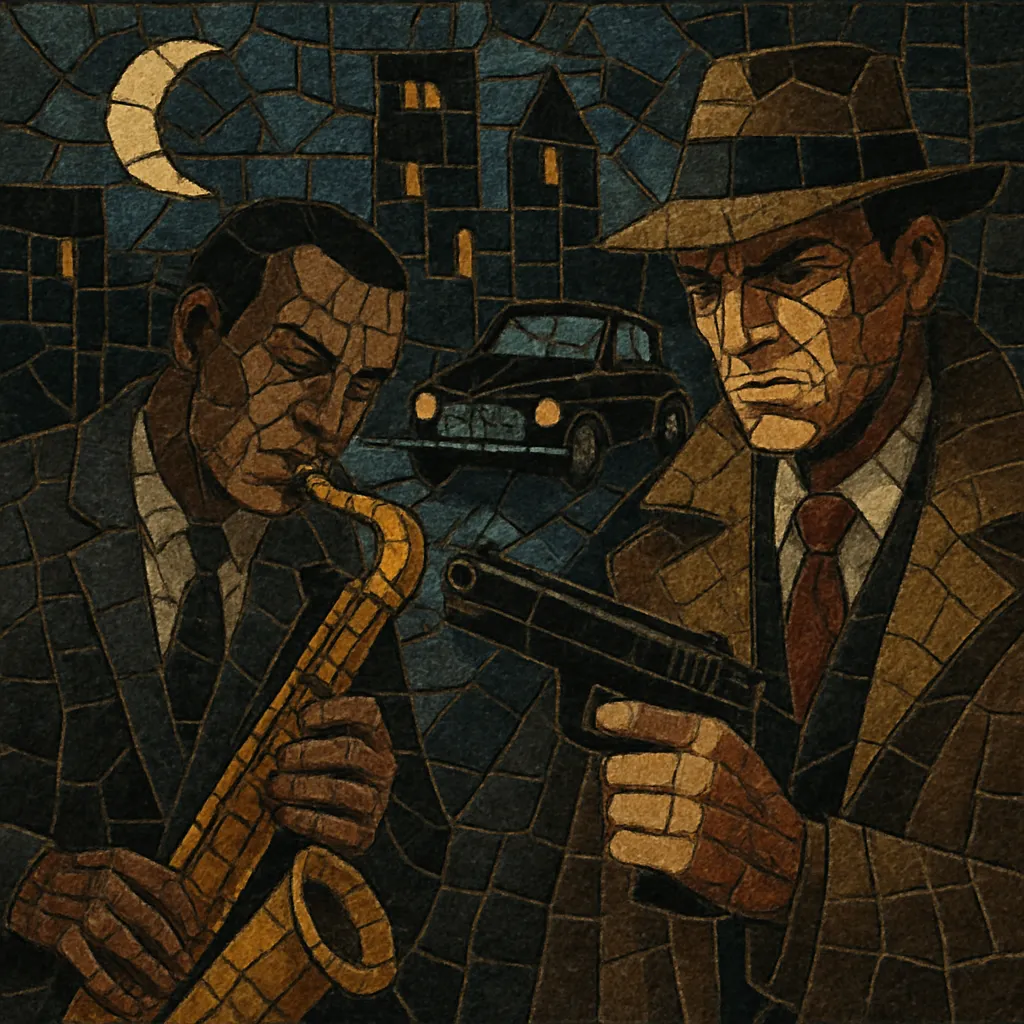
Crime jazz is a hard‑edged, cinematic strain of mid‑century jazz associated with film noir and crime/detective television of the 1950s and 1960s.
It blends big‑band punch with small‑combo cool, favoring minor keys, bluesy and modal harmonies, ostinatos, and sharply punctuated brass figures to evoke tension, pursuit, and urban grit.
Typical textures include driving walking bass, brushed or tightly played ride‑cymbal swing, vibraphone shimmer, tremolo electric guitar, smoky saxophones (often baritone/tenor), and muted trumpets for stealthy, nocturnal colors.
Arrangements are concise and motif‑driven (cue‑based), using stingers, crescendi, and sudden dynamic contrasts to match on‑screen action and suspense.
The roots of crime jazz lie in postwar film noir scoring, when American composers began folding contemporary jazz idioms into orchestral soundtracks to depict modern, urban tension. Early landmarks include Alex North’s jazz‑inflected dramatic scores and Elmer Bernstein’s The Man with the Golden Arm (1955), which demonstrated how a jazz ensemble could carry narrative intensity as effectively as a classical orchestra.
The style crystallized on television and at the movies: Henry Mancini’s Peter Gunn (1958) became the template with its propulsive ostinato, bold brass, and moody minor harmonies. Pete Rugolo, Nelson Riddle, Johnny Mandel, and Quincy Jones developed the sound across detective and crime series and films, refining its palette with vibraphone, baritone sax, and muted trumpet colors. Lalo Schifrin’s late‑1960s work (e.g., Bullitt, and adjacent spy‑jazz idioms) brought tougher grooves, Latin accents, and modern harmony, extending crime jazz into a more contemporary, streetwise feel.
As film scoring diversified in the 1970s, crime jazz’s language persisted in neo‑noir and urban thrillers (e.g., Jerry Goldsmith’s Chinatown), while its textures—nocturnal horns, walking bass, tremolo guitar—became shorthand for danger and intrigue. From the 1990s, lounge revivals and crate‑digging producers reintroduced the style to new audiences. Hip hop, jazz rap, and trip hop sampled and recontextualized mid‑century crime themes, while modern composers continue to reference the idiom for gritty, metropolitan atmospheres.
Start with a compact jazz unit augmented for cinematic punch: drum kit (brushes and sticks), upright bass, piano, vibraphone, electric guitar with amp tremolo or spring reverb, and a brass/reed section (trumpet with cup/straight mute, trombone, alto/tenor/baritone sax). Add hand percussion (bongos/congas) for Latin‑tinged cues.
Use medium to up‑tempo swing for chase energy, or half‑time, simmering swing for stealth. Establish ostinatos (e.g., bass riff plus ride‑cymbal pattern) that can loop under dialogue. Occasionally switch to Latin grooves (mambo/cha‑cha) for period‑authentic tension.
Favor minor keys, Dorian or Aeolian modes, and blues language. Employ extended/altered dominants (b9/#9/#11/13), tritone substitutions, minor‑major 7 chords, and chromatic approach tones to add noir color. Craft short, memorable motifs that can be sequenced, reharmonized, or layered for escalating suspense.
Shape cues around hits and stingers that sync to on‑screen edits. Use call‑and‑response between brass and saxes; thin textures (bass + brushes + guitar tremolo) for surveillance; full brass with sax pads for action. Exploit dynamics—sudden sforzandi, swells, and drop‑outs—to create shock and release. Vibes and muted trumpet signal nocturnal mood; baritone sax anchors low, gritty lines.
Keep the rhythm section tight and forward; add plate/spring reverb or slapback for period feel. Double important lines (e.g., vibes and guitar) for shimmer. Record dry enough for clarity, then use selective reverb for space. Build cues in modular sections to accommodate edits, reprises, and overlays.

